Peter MALONE
Odisea de los giles, L'/ Heroic Losers
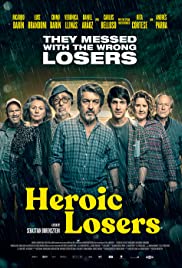
L’ODISEA DE LOS GILES/ HEROIC LOSERS
Argentina, 2019, 116 minutes, Colour.
Ricardo Darin, Luis Brandoni, Veronica Llinas, Chino Darin, Daniel Araoz, Andres Parra.
Directed by Sebastian Borensztein.
Heroic losers seems a fair title for a film about a group of Argentinians who are swindled and robbed and fight to get their money back. But, it is the Argentinian title which is intriguing, the idea of an Odyssey, wandering towards a goal to be recovered – but then the question of los giles might mean. The Wikipedia answer: "Giles" is the plural of "gil". And "gil" is quite a word used in Argentina and Uruguay. It translates "simple person, naive, silly, over-confident”. And, in fact, the voice-over explains that this description covers those involved in this recovery exploit. It is repeated at the end, but that is after we have seen what the heroic losers have achieved.
This is a film about the working class in Argentina, memories of the dictatorship of the generals, the Falklands war, the need for Argentina to get on its feet again – only to have the financial collapse of 2001, the very months in which this film opens.
Service station owner, Fermin Pelassi (played by Argentina’s pre-eminent actor, Ricardo Darin) and his wife, Lydia, decide that they want to start a cooperative, using silos that have been abandoned for some time. The first part of the film introduces quite a range of characters, Ferman and Lydia’s approach to them, she being extremely forthright (and audiences will regret that she vanishes from the film in its middle, but, thankfully, being seen again in some happy flashbacks).
This gives the screenplay the opportunity to present a group of “fools”, several of whom are not the sharpest tools in the kit. But, they all have some money put by, the manager of the local railway station (where trains no longer stop), the shrewd repair shop owner (a self-proclaimed anarchist arguing against the station manager who is convinced Peronist), a squatter with an ever-increasing family who believes in action up front, two happy but dim-witted brothers, a mother who is a wily financier, continually criticising her son but wanting him to join the group.
Not without quite some effort, they get the money! And then, disaster for Argentina and its finances – and, worse, the smooth bank manager persuades Ferman not just to keep the cash in safety deposit box but to invest it in the bank. Instead, he steals it, building a huge underground vault out on a farm, metal, alarms installed, safe-proof.
The second part shows the enterprise for getting the money back – some comic touches,a great deal of naive activity, Ferman planting his son, Roderigo (played by Ricardo Darin’s son, Chino) who has had to stop is university studies, pretending to care for plants but keeping surveillance on the crook, but, fairly lightly, the beginnings of a romance with the secretary in his office.
Naturally, we, the audience, are getting more and more on side, certainly wanting to get the money back, certainly loathing the crooked banker, checking out the details of security on his safe, watching the elaborate plan to get the banker to switch off his alarm battery (learning a technique from Peter O’Toole, seen in the 1966 caper, How to Steal a Million!) By continually setting off the alarm until he acts, frustrated.
And then, of course, there is the big scene, the raid on the vault – and, will they succeed! No surprise, but, by the end, we are all happily complicit and everyone deserves a happy ending.
- The title? The implications of the original title? The comment on the protagonists as “simple”, “fools”?
- The Argentinian setting, the provincial town, hard times, service stations, repair shops, businesses, the abandoned silos, the banks? The aftermath of the difficulties of the 1980s, dictatorship, Falklands war? The film as set at the time of the financial collapse in 2001?
- Ferman and Lydia, their age, experience, the service station? Roderigo away at studies? The plan for the cooperative? The initial explanation to Antonio? Persuaded? His anarchist and Bukanin background? The approach to the various contributors, Rolo and the railway station, no train stopping but his working there? The two brothers, simple-minded? Medina, squatting, his extended family, increasing, the money granted and his spending it? The visit to Carmen? Finance, her disappointment with her son? The visit to the Turk, clashes? Everybody contributing? The building up of the finance? The two brothers and their mobile phones, no one to ring, ringing each other at the end?
- The visit to the owner, the discussions about Ferman and his reputation as a footballer, his statue in the town? Getting a discount?
- Going to the bank, the discussions with Manzi, smooth talking, persuading Ferman to move from the safe deposit box to investing in the bank?
- The financial crisis, people losing their money, the run on the banks? Ferman, blaming himself? The Turk and his hostility, Lydia with the gun? The others accepting the situation and supporting Ferman?
- The disaster of the car crash, Lydia’s death?
- The bank employee, his giving the information about Manzi and his colleague, their taking the money? The information about the underground vault?
- Going to scout the location of the vault, finding it, the alarm? Rodrigo returned from college, working with his father, allegedly the horticulturist, surveillance in Manzi’s office, Florencia and their discussions? Manzi and the alarm and phone call, driving to the site? The phone call, the warning, everybody of the property, Manzi reassured?
- Roderigo, calling himself Miguel, the discussions with Florencia, his awkwardness with the? Attracted to Florencia, the bouquet, asking her out? Her suspicions, threat to tell Manzi?
- Ferman and Roderigo going to the makers of the battery (and Rodrigo spying on the account books)? The explanations? The secure vault? Electricity and battery?
- Furman watching How to Steal a Million, Peter O’ Toole’s technique? Their employing it, with the electricity, on and off, the battery and its going below 50%, Manzi having to hurry so often to the vault site? Exasperated, threatening the manager of the battery, turning it off?
- Waiting for the storm, dynamite, the plan to cut off the electricity? The lightning, the failure of the plan, the trip, the dynamite, the huge explosion? Blackout? Manzi at the party, his realisation, driving fast? The group, opening the vault, collecting the money, success?
- Carmen and her son, his taking the money and disappearing, his mother rightly suspicious?
- Time passing, the establishing of the cooperative, everybody happy?
Moonbound
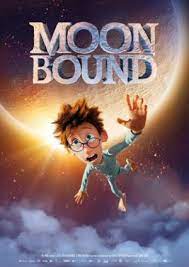
MOONBOUND
Germany, 2021, 85 minutes, Colour.
Directed by Ali Samadi Ahadi.
Once again, for this kind of animation film for younger audiences, the opinions of film critics with analysis is rather irrelevant as to whether the children enjoy the film on not. There were high hopes for Moon bound, German production, but world release in 2021. It is based on a popular children’s novel by Jonathan Fetter-Vorm.
At the end of the film, the two central characters, Peter (who loathes being called Petey) and his younger sister, Anne, wake up in their bedroom and both agree that they have had weird dreams. (But, of course, they actually lived through their dreams!) “Weird’ may be the view of the children – and is probably the view of the adults who watch this extraordinary variation on fairytales. On the other hand, the publicity for the film refers to the journey as “magical”. The synopsis takes this much further and describes it as “enchanting”. That would not be the reaction of this reviewer except if “enchanting” is interpreted in the sense of powerful magicians imposing spells.
As the film opens, Peter finds Anne absolutely annoying (and he is not wrong). Anne, lively and feisty, considers Peter her “idiot brother”. He is bullied at school but she stands up for him. His dream is to be an astronaut and go to the moon.
At the same time, there is little subplot about Beatles, enchantment, spells, a tree uprooted and going to the moon, the beetle losing one arm as well as his wife. He is determined to get back to the moon if only he can find three humans to help him.
We certainly then enter a world of enchantment, a fairy Queen (who could do with a course on management as well as empathy) gets involved trying to help, but Anne is abducted by the grim moon man and his henchman and trapped with some insects. (And that is only the beginning of the complications…!). Peter and the beetle are joined by the Sandman (the one who puts people to sleep) and a whole cohort of Nature Spirits. And a giant polar bear transports Peter and his group, leaping through space and clouds, to the moon.
And, all kinds of shenanigans, conflicts, pratfalls, magic, crises involving rescuing and, the beettle restoring his arm, Peter and his sense of achievement.
But, all in all, it seems that this is a film for the littlies audience rather than even the older pre-teens, and not for the teens. So much colour, so much movement, so many complications, not necessary to follow all the details the plot but for the littlies to be swept up by it all.
Herself
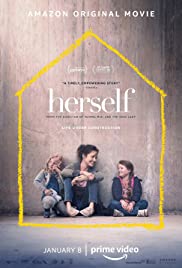
HERSELF
UK/Ireland, 2020, 97 minutes, Colour.
Claire Dunne, Harriet Walter, Conleth Hill, Molly McCann, Ruby Rose O'Hara, Ian Lloyd Anderson.
Directed by Philippa Lloyd.
Herself it is, as the Irish say. And they say it here, in this contemporary story from Dublin.
Domestic violence, a sadly relevant theme at any time but, particularly, in these times when discussions are much more public, when there are campaigns highlighting the prevalence of physical and psychological brutality in the home.
And, yet, this is a very positive film. It shows a woman, victim of violence, yet becoming more than a victim, even more than a survivor, a woman who discovers purpose and acts on it. Actress Claire Dunne who portrays this woman, Sandra, (Claire Dunne contributing the story and cowriting the screenplay), won an award from the Women Film Critics Circle for her performance, for “Women Saving Themselves”.
Sandra is a loving mother, with two little girls, seen playfully romping with them as the film opens, their father arriving home, the little girls running to him, then the father turning on Sandra beating her, stomping on her wrist. Sandra leaves with the girls. And, later, there will be conflict about child custody, hearings in the court, Sandra making the comment there as to when she was asked why she didn’t leave, the question should have been to her husband, to be asked why didn’t you stop?
Sandra has to find accommodation, take the older girl to school, work in a bar as well is make ends meet along with child support by looking after a recovering invalid, Peggy, who had been a doctor. Sandra’s mother had worked for Peggy and they had been friends. Peggy is played by that marvellous stalwart of British film and television, Harriet Walter. This aspect of the screenplay shows how blessed it is to have friends, supportive friends who will step up in their help. And this theme continues throughout the film, the value of friendship, people working together.
Because, In fact, Sandra discovers an online builder explaining how one could build one’s own house. And this is where Sandra comes into our own, doing all the investigations, the financial implications, seeking advice, Peggy being financially supportive, Sandra making the decision to build. And, the sequences where, every weekend, Sandra and a friendly builder and his Down Syndrome son, a mother from school, a young woman who works at the bar, bringing some friends, patiently, with a zest, build that house. “Women saving themselves.”.
We are not prepared for an appalling shock towards the end of the film – audiences will recognise it when it happens. And, while there are custody difficulties, issues with the affections of the children, patience and perseverance, the film ends with a wonderful small sequence of hope. Sandra is well and truly ‘herself’.
- An Irish story? Universal story? Family? Domestic violence? Consequences? Custody? The building of the house?
- The Dublin settings, the city, homes, streets, apartments, courts, open ground? The musical score? Irish songs?
- Sandro’s story, Claire Dunne’s performance, contributing the story and cowriting the screenplay?
- Sandro, playing with the girls, Gary arriving home, the children’s reaction, his violence, stomping on her wrist? Her leaving? Taking the girls? Finding accommodation? Her work, helping Peggy? In the bar? Managing, taking Emma to school, the discussions with Rose? The pressures on her, taking the children to carry this parents? Emma going, Molly frightened and refusing? This being used in evidence against Sandra?
- Sandra, the video of the homebuilder, his enthusiasm, explanations? Her doing the research? Going to the store, explanations? The encounter with a doe? Asking his help? His wariness? His links with the Gary? Sandro meeting him, his advice, taking his son, the genial son giving the boots to Sandra, Down syndrome?
- Peggy, her past, fragility, Sandra caring for her, Sandro’s mother and the friendship? Her own family, her daughter’s protest? Giving the money to Sandra for the building?
The Fast and the Furious 9/ F9/ F9: The Fast Saga
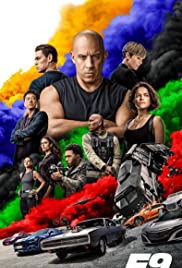
THE FAST AND THE FURIOUS 9/ F 9/F9: THE FAST SAGA
2021, 143 minutes, Colour.
Vin Diesel, Michelle Rodriguez, Jordana Brewster, Tyrese Gibson, Chris 'Ludacris' Bridges, Nathalie Emmanuel, Charlize Theron, John Cena, Finn Cole, Sung Kang, Anna Sawai, Helen Mirren, Kurt Russell, Lucas Black, Michael Rooker, Shea Whigham, Jason Statham.
Directed by Justin Lin.
‘I never even knew you had a brother’. This quote suddenly came to mind (surprisingly, since it comes from Oscar Wilde’s The Importance of Being Earnest) during the prologue of this ninth edition of the Fast and Furious franchise. Hollywood has been delighting in origin stories so, unexpectedly, the film opens in 1989 revealing Dom Toretto’s father and his younger brother, Jacob. Some dubious goings-on, some regrets, clashing brothers which will be taken up (with a vengeance or more) during this almost 2 ½ hours of action, speeding cars, chases, crashes and smashes, explosions – one might say a hyperbole of mayhem.
And, while in the vein of metaphors, an extravaganza of implausibility! Even when two characters literally go into space. And, while we can welcome the great variety of international cities we visit, Cologne, Tokyo, London, Edinburgh, Tiblisi, often quite scenic if we distract ourselves from the car chases, the implausibilities that characters can move from one city to another seemingly just thinking about it!
It is all familiar territory and, probably, most fans will be pleased (although there always seem to be trolls ready to text that they hate inferior sequels). Characters from the previous films suddenly turn up, Charlize Theron in a glass case, Helen Mirren bejewelled and begownned and driving a speeding car (and, we suppose, that if it’s all good enough for Helen Mirren, then it’s good enough for us!). But, which films did they appear in? And what about Kurt Russell turning up as Mr Nobody? And all the Japanese connections, Tokyo Drift?
For those who do not retain all the details of the previous films, it would be very handy if there someone like a contestant on Hard Quiz whose expert subject was the Fast Franchise sitting beside us instantly reminding us who was who and where was where and when was when!
Vin Diesel gives his usual performance. Michelle Rodriguez and Jordana Brewster get a bit more action time. There is the comic patter between Tyree’s Gibson and Ludicrous – which we may (or not) find funny.
And, then there is the whole espionage story, power and space, which does seem a little far-fetched.
But, for those who are wanting the familiar characters, the cars, speed, chases, crashes, personal rivalries and confrontations, who can complain?
- The ninth contribution to the franchise? 20 years, fans over the decades? The characters, cars and issues, broadening the scope of the series, International, gangsters, espionage, space? Gathered together in this one film? And the range of characters and references?
- Audience familiarity with the characters? Dom is the centre of the series? Past history with Brian and Brian’s son? Letty, marriage to Don? Mia, Don’s sister? Ted Jan Roman and their comedy? Revisiting with her, Queenie, Mr Nobody? The connections with Tokyo?
- Introducing Dom’s brother, 1989, their father, the race, in debt, fixing the race, not telling Dom, Jakob complicit? The father’s death? Dom blaming Jacob, prison, his emerging, after the decades, involved in international plans, domination, space?
- The domestic sequence, Norma and Letty with Brian at home? And the end of the film, as with others, everybody gathered for the meal?
- Ted Jan Roman, involving Dom, the issue with Jacob, with Cipher?
- The episode in Mexico, the chases, crashes, Jacob and his presence, the two brothers confronting each other?
- The further episodes, Tom being further involved, Letty following, mere and her presence? The visit to Tokyo, connecting with old friends, the emergence of the young woman, her DNA, the code for the machine and power?
- The visit to Cologne, Sean and his friends, experimenting with rockets, the explosion? Later relying on them for the rockets and the spacecraft?
- The visit to London, the encounter with Queenie, the social, upper-class, her driving, making connections?
- Jacob, the international connections, the ambitious young son resenting his father, finance, socials, international intrigue?
- Tblisi, everybody present, the plans, Cipher out of the glass? Control?
- Don, the team, pursuits? The chases? The betrayal of Jacob? Dom and his rescue? They’re working together?
- Issues of space, the satellite, the implausibility of Tension and Roman going into space, the comedy and patter, success?
- The defeat of the enemy? Possibilities for world peace? Family reconciliation? And the final meal scene?
Murder in Mexico: The Bruce Beresford-Redmon Story
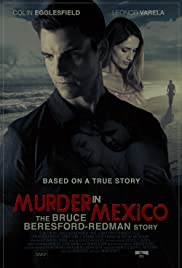
MURDER IN MEXICO: THE BRUCE BERESFORD-REDMON STORY
US, 2015, 88 minutes, Colour.
Colin Egglesfield, Leonor Varela, Dakota Bright, Ashton Essex Bright, Samantha Sloyan.
Directed by Mark Gannt.
As seen by the title, this is a murder case investigation. It is based on a true story, outlining the issues of the characters, the murder, the investigation in Mexico, the various court appearances over the years, the imprisonment of the central character.
The treatment is on a very popular level, something of the style of the popular soap opera.
Bruce Beresford-Redmon, played by Colin pickles for, is a producer for Reality Television program. He is married to Monica, Leonor the regular, and they have two children. All seems to be well. However, there is some tension in the marriage and Bruce has a roving eye, begin an affair with one of his assistants at studio, despite the alert and the warnings of his best friend, another producer.
Tension in the house, Monica sensing something wrong, checking on phone records, discovering the truth, and her confronting the other woman. All this sends Bruce into rages, especially Monica is going to confront his assistant. There is potential for violence in Bruce. Despite his protests, he still keeps contact with the woman – but she has opted not to be a home wrecker and breaks contact with him.
The solution is to take a holiday in Mexico, parents and children. There are attempts at reconciliation, Monica still seeming to love her husband but, again with the phone, discovering that he has been texting the assistant. There are confrontations.
Bruce goes to the police claiming that his wife is missing, is searching for her. With the interrogations, the local police are sceptical. They have evidence from a holiday couple in the next room at the hotel who heard argument and noises in the early hours of the day of the disappearance. Eventually, Monica’s body is found near the hotel. She has been asphyxiated after being hit on the head.
Bruce continues to proclaim his innocence, surrenders his passport, the local police very suspicious of him. He sends his children to his parents despite the fact of the offer from Monica sister who comes to Mexico. Monica and her sister were very close, confiding in each other.
Bruce hitchhikers, being picked up by a car, crossing the Mexican-American border by producing his drivers license.
There is very little sympathy for Bruce on the part of the filmmakers even though they try to show the range of evidence for and against him.
At the time of production, Bruce Beresford-Redmon was still in prison.
Spirit Untamed
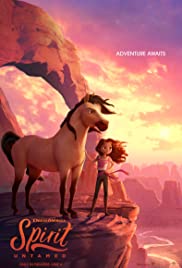
SPIRIT UNTAMED
US, 2021, 88 minutes, Colour.
Voices of: Isabela Merced, Jake Gyllenhaal, Marsai Martin, Mckenna Grace, Julianne Moore, Walton Coggins, Eliza Gonzalez, Andre Braugher.
Directed by Elaine Bogan, Ennio Torresan.
As the title indicates, this is quite a spirited animated entertainment, suitable for family watching.
It has been a long time since the first film featuring Spirit: Stallion of the Cimarron (2002). But, the television series has kept alive the story of Spirit. It is enjoyable to continue the narrative (which does go back to some of the television episodes).
We are introduced to Lucky Prescott (voiced vigorously by Isabela Merced) , a young girl even more spirited than the stallions racing through the countryside. We also see something of her mother, in a flashback, a champion at rodeos, skilled in show-riding horses, sadly dying in an accident. Lucky is looked after by her (initially) rather prim aunt, Cora (Julianne Moore). Lucky gets into all kinds of mischief, getting into the most awkward situations, quite unrepentant - ruining her grandfather’s campaign to be Governor. She and Cora are to go out to the West, for the summer vacation, to meet her father whom she has not seen for years, railroad engineer, still grieving for his wife.
Looking out the train window, she sees Spirit and the other stallions, delighted, full of glee, barging through the carriages to get to the back, mayhem on the train, rescued by a tough hombre (who turns out to be the villain, leader of a group of bank robbers who plan to rustle the stallions).
But this is the story is of Lucky and Spirit, her learning to tame him, the bond between them, some exciting and dangerous rides, the pursuit of the rustlers, a death-defying trip through high-peak mountains and a precariously dangerous ridge… But, Lucky is not alone. She has to great friends her own age, Prue and Abigail, who share her adventure to rescue the stolen stallions.
This is very much a film for the female audience – perhaps one thinks of the word feminist! The three young girls are tough, can survive in the West, bond together (and an inter-racial friendship). In fact, the men don’t really get much of a look in! Lucky is father, Jim (Jake Gyllenhaal) is a rather soft and protective father, in the background. There is a young boy who gets up to mischief and rides and obstinate little donkey. Prue’s father is sympathetic managing the corral. But the villains are all those tough men. If it has been felt in the past that women have been relegated to subordinate roles secondary roles in westerns, Spirit Untamed certainly makes up for it, the men definitely subordinate.
The animation is vivid, the locations beautiful and arresting, the racing of the horses exhilarating, all on a big wide screen.
The target audience is the pre—teen children’s audience, especially girls. While young boys watching the film might feel of the outer, parents will probably enjoy it.
- The spirit of the sequel, the impact of the original film, the television series? Revisiting? The target audience, young children, families, especially young girls?
- The animation style, the backgrounds, the city, the view from the train, the West, the open spaces, the mountains, the Bridge, the port? The musical score?
- Lucky, age, background, memories of her mother and her riding, the absence of her father, care by And Cora, her grandfather and his politics, her being mischievous, curious, ruining the campaign launch? Cora trying to keep her out of trouble?
- The trip to the west, Lucky and her attitude torture absent father? Mischief on the train? Seeing the horses, barging through the carriages, at the back, reaching out, Hendrix rescuing her? And the irony of Hendrix and his role in rustling the horses?
- Her father, his grief, the railroads, working on the engine? His response to Lucky?
- Lucky, seeing Spirit from the train, seeing him again, the treatment, her approach to him, the apples? Her friendship with Prue, Prue and her verve? Abigail, lively? The little brother and his writing the donkey, mischief? Lucky and her taming of Spirit?
- Hendrix, his cronies, robbing banks, the decision to take the horses? The roundup, taking the train, the escape? Planning to sell?
- Lucky, the memories of her mother, the visuals of her mother and riding, the sadness of her death? Lucky and a clash with her father, not talking to him?
- The ride on Spirit, loose, into the mountains, leaving the chasms? The girls in pursuit?
- Lucky, the discovery of the taking of the horses, her decision to pursue, with the girls, the map, the plan, the mountains, the dangerous ridge, arriving at the port, the rustlers already there?
- Jim, the train, Prue’s father and the corral, arriving at the port?
- The action at the port, Hendrix and Cora, the horses, Lucky liberating them? The fights? And Cora even hitting one? The happy resolution?
- The emphasis on girls and women and their presence in the West, contrasting with past films? The men in subordinate roles?
My Zoe

MY ZOE
UK/Germany/US, 2019, 100 minutes, Colour.
Julie Delpy, Sophia Ally, Richard Armitage, Gemma Arteton, Daniel Bruel, Saleh Bakri, Lindsay Duncan.
Directed by Julie Delpy.
My Zoe is very much a film by Julie Delpy. After a substantial career as an actress, in French cinema as well is in the American movies, she moved into writing and direction. She has both written and directed My Zoe and stars in it.
But, what she has provided is two films in one – or, rather, one film, then a complete change of pace and another in the latter half.
The first part of the film is set in Berlin. Julie Delpy plays Isabelle, a research scientist, separated from her British husband, James (Richard Armitage), caring for her young daughter, Zoe (Sophia Ally). James blames Isabel for the alienation, especially after the birth of Zoe. He has become aggressive, even violent towards his wife but devoted to his daughter.
The key of the first part of the film, the first film, is Zoe becoming ill, the concern of her parents, the mystery of the illness, hopes for recovery, the dashing of these hopes and the consequences. This is a sad and challenging film in itself.
But, after the death of Zoe, Isabelle does not seem to go into mourning, and the film changes tone completely. Isabelle draws on her science background and the film becomes an exploration of science, genetic engineering and experimentation, moral issues, legal issues. The new setting is Moscow and introduces two significant characters, Thomas (Daniel Bruel) and his wife (Gemma Arteton), the film moving into quite some dialectic, serious conversations between the three central characters.
And this is what films can do – raise moral and ethical issues in principle but dramatise them through the characters and their crises, challenging audiences to think but also challenging audiences with empathy and potential conflicts between the two.
There is an enigmatic final aspect of the screenplay but audiences who have been alert, even puzzled, during the opening credits and the focus on pregnancy, will realise at the end something of what has happened.
Better for a review to stop here – no spoiler alerts.
- The title and its focus on the young Zoe? The impact of her illness and death? The second part of the film, cloning, success? The title and the focus on Isabelle and her love for her daughter, possessive of her daughter?
- The European settings, the city of Berlin? The transition to Moscow? The musical score?
- Julie Delpy, producing and directing, writing, taking the role of Isabelle?
- The family situation, international backgrounds and parents? International travel and work? The alienation between husband and wife? The concerned for their daughter, custody? Legal issues? Arrangements? The effect on Zoe?
- Zoe, her age, vitality, at school? Her response to each parent, love? The response to the babysitter? At school? Having the cold, concerned? The night, in a coma, hospital, the surgery, the treatments, injuries to the brain? The decision to turn off life support? The babysitter and her mother, not reporting the accident and dizziness? Her shame?
- James, his background, the marriage, devotion to his daughter, alienation from his wife, harsh and confronting? Issues of custody, outings? Resistance to helping and picking up from school? Isabelle and her needs, job applications? His criticism of her stances taught work? The impact of the accident, the vigilant both parent to the hospital, the decisions?
- Isabelle and her British mother, the visit, the clashes and arguments?
- The film changing and becoming another film? Isabel, the visit to Moscow, taking the samples from Zoe? Her intentions?
- Audience reaction to this story, cloning, stem cell research, issues of morality, issues of the law? The impact of the mother, the procedure for her rather than for her daughter? The status of this kind of cloning and medical ethics?
- The visit to Thomas, discussions with him, his reiterating the morality and the law, his personal talents and research? The discussions with his wife? His associate? Isabelle and her putting her case, pleading? His decision, the visualising of the procedures, the number of samples, one in reserve? Pregnancy, miscarriage? His final decision, the issue of surrogacy, discussing it with his wife, her initial reservations, the meetings with Isabel, the discussions, empathy?
- The issue of surrogacy, the initial image of Thomas’s wife and her pregnancy? And the screenplay not making explicit that she had been the surrogate for the pregnancy?
- Years passing, Isabelle, in Moscow, Zoe growing up, as she was when the film opened? James and his visit, his own life, in London, the son?
- The overall impact of both parts of the film, emotional, ethically challenging?
Design for Living
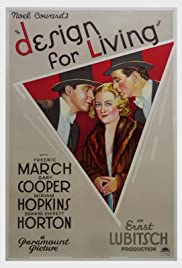
DESIGN FOR LIVING
US, 1933, 91 minutes, Black-and-white.
Fredric March, Gary Cooper, Miriam Hopkins, Edward Everett Horton, Franklin Pangborn, Jane Dale will.
Directed by Ernst Lubitsch.
There is a phrase, The Lubitch Touch. It is evident here in this light romantic comedy – with irony. The screenplay, by celebrated writer Ben Hecht, is based on a play by Noel Coward although commentators note that there is very little of Coward dialogue here.
The film opens on a French train, two central characters asleep, Miriam Hopkins Gilda arriving, sketching them – Gary Cooper an artist, Fredric March an unproduced playwright. The film shows the two men in pursuit of Gilda, she flirtatious, hard to get, involved with her boss of five years played by Edward Everett Horton in his usual bumbling performance.
The screenplay is a series of contrived encounters, Gilda playing one off against the other, the two men with their rivalries but also with gentlemen’s agreements. And their hostility towards Edward Everett Horton.
The film is full of smart dialogue, flirtatious situations. It is a surprise to see Fredric March at the beginning of his career (having just won an Oscar for Dr Jekyll and Mr Hyde and appearing in DeMille’s Sign of the Cross at this time), Gary Cooper more of an action hero. He was to appear later in Lubitsch’s Bluebeard’s Eighth Wife.
Lubitsch was later to direct the classics, Ninotchka and To Be or Not To Be.
Fatherhood/ 2021
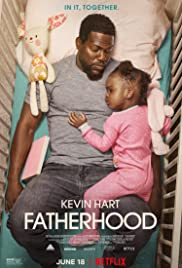
FATHERHOOD
US, 2021, 90 minutes, Colour.
Kevin Hart, Alfre Woodard, Lil Rel Howery, DeWanda Wise, Melody Hurd, Paul Reiser, Anthony Carrigan, Frankie Faison.
Directed by Paul Weitz.
Usually, we expect to find Kevin Hart in a raucous comedy (think the Ride Along films, The Wedding Ringer), sometimes teaming up with Dwayne Johnson. And, he is usually frantic. He i Fatherhood, but this is a far more serious film than usual.
He plays Matt, a successful businessman, on the up and up in New York City. His wife is about to give birth – and does so, a daughter, Maddie, but the immediate sadness of his wife’s death.
This is a film, particularly for fathers, particularly of young children, and daughters.
Much of the advice of his mother and mother-in-law (a very forceful performance from Alfre Woodard), refusing to go back to Michigan where his family came from, he decides that he will rear his little girl by himself – or, at least, with his friend from work, Oscar, and attending some mothers’ groups… And, more or less, he succeeds, not without great demands on his work and his personal life… those sleepless nights…
Father and daughter grow up nicely bonding. Five years pass. The crisis of the film is whether he should follow through possible promotions at work, including international travel, having his daughter go to stay with the family in Michigan. And, there is a complication. He meets an attractive woman, but the possible conflict between her and Maddie is not part of the drama of the film. They bond beautifully.
So, a shift of seen to Michigan, Maddie staying in her mother’s room, the fuss of the family, Matt and his re-living the past, having to make decisions about the future.
Not a groundbreaking scenario – but, with Kevin Hart more sympathetic, with Alfre Woodard unsympathetic (most of the time), and Maddie a likeable little girl and very perky, this is a drama, with humour, to remind audiences of the responsibility of fatherhood, of devoted parenting.
- The title and expectations? Kevin Hart in starring role – his comic reputation, a more serious characterisation?
- A New York story? Work and home in New York? The hospital? The contrast with Minnesota, homes, countryside? The musical score?
- The pathos in the film? Matt, his wife’s pregnancy, the joy of the birth? The pressure from his mother-in-law? Support of his mother? The baby, the sudden illness, his wife’s death? The impact on him, the funeral and the wake, his despondency, Marion and her influence, his mother, Jordan as his friend continually intervening and supporting?
- The pressure on Matt to give his daughter to her grandparents, to Minnesota? His refusal? His decision to be a father, to do everything? His work and his skills, his sympathetic boss, the thought of firing him, his presentation to the clients, the intervention of his daughter? Their happy response? The expected sequences of life at home, feeding, changing nappies, crying during the night? The effect on Matt? His visit to the mother’s group, their welcome, advice? His managing to cope?
- Marion, strong character, love for her daughter? Grief at her daughter’s death? The husband and his easy-going manner? His being supportive of Matt? Phone calls, visits, unexpectedly turning up? The contrast with Matt’s mother and her support?
- Maddie growing up, going to school, the nuns in memory of her mother, wearing the trousers and the severity of the regulations, the discussions with Matt (and at the end his wearing a skirt)? Her personality, verve, keeping her father attentive?
- Matt and his continued work, possibilities for promotion? His boss and his retirement?
- Oscar, his continued presence, awkward, talking too much, his wife? Along with Jordan and their support of Matt, taking him out, the bar, his refusing?
- The encounter with Swan, her personality, Matt responding to her, meetings, talking, the relationship? Maddie and her relating well with Swan, going out, enjoying her company?
- Matt, change of heart, the tension with Swan? His later apology, the reconciliation?
- Maddie going to Minnesota, her mother’s house, her mother’s room? The grandparents? Missing her father? His memories of Minnesota, nostalgia, sadness?
- Matt going overseas for work, with Oscar, leaving Oscar to do the job?
- The reconciliation with Maddie, return to New York? The resolving of all the issues?
- A film for men, the fathers, for fathering, bonding with children?
In the Heights
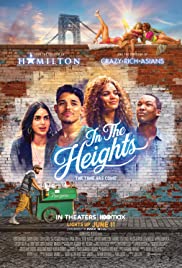
IN THE HEIGHTS
US, 2021, 143 minutes, Colour.
Anthony Ramos, Melissa Barrera, Leslie Grace, Corey Hawkins, Olga Merritt is, Jimmy Smits, Gregory Diaz IV, Lin-Manuel Miranda, Marc Anthony.
Directed by Jon Chu.
The Heights? Washington Heights – the northern part of New York’s Manhattan where the island narrows between the Hudson River to the west and the East River to the east. For the last decades it has been a centre for migrants from Caribbean countries. And here, these cultures are being celebrated.
In the Heights was written by Lin-Manuel Miranda, the name to be reckoned with for the American musical in the 21st-century. He has been immortalised with Hamilton. In fact, in the Heights was written before Hamilton but now it is getting the big screen treatment, directed by Jon Chu who directed a number of dance films, Step Up, but achieved great popularity with Crazy Rich Asians.
A prominent reviewer treated In the Heights with more than a touch of disdain, condemning it as “sanitised”. The reviewer was referring to the social problems in the area, especially drugs and violence, killings – and, in 1989, the New Your Times did state that Washington Heights was the crack capital of the world. It is true that these issues are not to the fore here. Rather, this story intends to be a celebration, a celebration of the Latino cultures, the memories of homelands, the transition to the US, making a home in the US. It has the touch of the fairytale – and, that is certainly true of the end of the film and its resolution with a lottery ticket.
There is quite a lot of singing and dancing in the street. On a personal note, this reviewer did spend a year living in Washington Heights, 1989, and resonated with the story and the characters, the filming on the streets of Washington Heights, the precise situation of Usnavi’s store on the corner of Audubon Avenue and 1/75 Street. But, this reviewer has to confess that he never saw any dancing in the streets although there was often a very festive atmosphere, celebrating the many patrons under the title of the Virgin Mary and the countries of origin.
The central character is a young man, Usnavi (Anthony Ramos) who tells stories about his growing up in the Dominican Republic to attentive children, who works a stall with the young Sonny, who is attracted to Vanessa (Melissa Barrera) who works in the local beauty shop (which is transferring to the Bronx). His good friend is Benny (Corey Hawkins) who works for Kevin (Jimmy Smits) who runs a local taxi service and bought it from the Irish. Benny is also in love with Kevin’s daughter, Nina (Leslie Grace) who has been sent away by her father to improve her studies at Stanford, though she does not want to study there, feels out of place, wants to return home. And, overall, there is the presiding spirit of the genial grandmother.
So, lots of verve, dancing in the streets, even on the side of an apartment block! But, compared with, say, West Side Story, this one is comparatively low key, a local celebration inviting us all to share. And, again, a commentator has referred to it as a love letter to the cultures of Washington Heights.
SOME BACKGROUND ON THE LOCATION: Washington Heights is set apart among Manhattan neighborhoods for its high residential density despite the lack of modern construction, with the majority of its few high-rise buildings belonging to the NewYork–Presbyterian Hospital / Columbia University Medical Center. Other higher education institutions include Yeshiva University and Boricua College. The neighborhood has generous access to green space in Fort Washington Park, Highbridge Park, and Fort Tryon Park, home to the historical landmarks the Little Red Lighthouse, the High Bridge Water Tower, and the Cloisters respectively. Other points of interest include Audubon Terrace, the Morris–Jumel Mansion, the United Palace, the Audubon Ballroom, and the Fort Washington Avenue Armory.
Beginning as a middle-class neighborhood with many Irish and Eastern European immigrants, the neighborhood has at various points been home to communities of German Jews, Greek Americans, Puerto Ricans, Cuban Americans, and Russian Americans. Throughout the 1960s and 1970s, White residents began to leave the neighborhood for nearby suburbs as the Black and Latino populations increased. Dominican Americans became the dominant group by the 1980s despite facing difficult economic circumstances, leading the neighborhood to its status today as the most prominent Dominican community in the United States. While crime became a serious issue during the crack cocaine crisis of the 1980s and 1990s, in the 2000s Washington Heights became a much safer community and began to experience some upward mobility as well as gentrification.
For the remainder of the 20th century the Dominican community of Washington Heights continued to increase considerably, most notably during the mid to late 1980s, when over 40,000 Dominicans settled in Washington Heights, Hamilton Heights, and Inwood Around the year 2000, the Dominican community reached its peak and became a slim majority of Washington Heights and Inwood, propelling the neighborhoods' combined population to 208,000, the highest level since 1950.
in 1989, The New York Times called the neighborhood "the crack capital of America." By 1990, crack's impact on crime was evident: 103 murders were committed in the 34th Precinct that year, along with 1,130 felony assaults, 1,919 robberies, and 2,647 burglaries.
Washington Heights has faced gentrification throughout the 2000s, with the 2010 Census revealing that from 2000 the neighorhood's Hispanic / Latino population had decreased by nearly 17,000 and its Black population by over 3,000, while its White population increased by nearly 5,000.
- The success on Broadway? Lin-Manuel Miranda, this musical before Hamilton? To the screen? The American cinema musical tradition? 21st-century style?
- The location photography, filming in the streets of Washington Heights, specific address, apartments, stores, the Latin American community, from the Dominican Republic? The studio work, special effects, dancing on the side of the wall…?
- The title, the title song, the rap lyrics? The range of songs, Latin American rhythms? Recitative lyrics? The cumulative effect for atmosphere? The choreography, participation, all ages? The atmosphere of the New York and race locations?
- The narration by Usnavi, his age, experience, memories of growing up in the Dominican Republic, the little bar, the story for the children, their response? Recurring throughout the film, his intention to return, set up the bar? The revelation at the end, in Washington Heights, with the children, his own bar there in the neighbourhood? His daughter, his wife? The optimism of the story?
- A film of New York Latin American culture? The migrants from the Caribbean, edging out the Irish (Kevin buying out the taxi company from the Irish)? The different countries, cultures and traditions? Spanish language? The bonds of the community, family? Ambitions, hopes, prosperity? The costumes and decor, for the younger members of the cast, older members? The touch of the flamboyant? Bright and colourful?
- Usnavi’s story, member of his family, the store, the photos, working with Sonny, the customers? His friendship with Vanessa? The dates with her, the conversations, her being upset with him? Vanessa, covered with the design, in the beauty parlour, its transferring to the Bronx? Her tensions, application turn down? Usnavi filing the application, success? Vanessa on the Washington Heights long steps, the painter, the colour design, ideas, working overnight? The dresses, the painting in the store? Usnavi packing to go to the Dominican Republic, changing his mind, staying?
- Kevin, the older generation, migration, buying at the taxi business, his success, selling part of the house and business, Nina and her education at Stanford? His work with Benny? Nina returning back, not wanting to be at Stanford, feeling isolated and humiliated? The scene at the dinner, Kevin selling the business, Nina’s outburst? Her later realisation of what she could do, returning to a father, her plans for advocacy for the future? Her relationship with Benny, his work for Kevin, her absence, coming together again? In love? And the dance on the wall?
- The grandmother, memories of the past, her embroidery work, supporting the younger generation, the lottery ticket, her dying? The irony of Usnavi discovering the ticket? His using it for Sonny’s green card? For his trip? Going to the lawyer, persuading him to cash the ticket?
- The seller of the iced drinks? His song? The rivalry with the ice cream vendor? Portrayed by Lin- Manuel Miranda?
- Sonny, his age, education, Usnavi visiting his father, his father’s resistance? Joining in the song and dance? Usnavi and the shop, giving him opportunity for the future?
- The range of supporting characters, the big the women at the beauty parlour, the transition to the Bronx, the owner and a disappointment at the blackout, people hot, lazy, urging them to celebrate?
- That this was the equivalent of a celebration of Latin American culture equivalent to the directors Crazy Rich Asians?